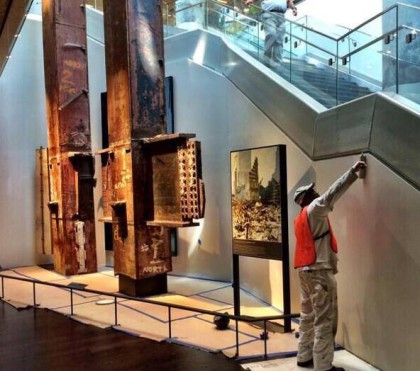In the News: Inside the 9/11 Museum
 ••• The New York Times reviews the 9/11 Museum, complete with an “interactive feature” guided tour. The notion of that day being packaged as entertainment—edutainment, if you must—freaks me out so much I can’t even discuss it.
••• The New York Times reviews the 9/11 Museum, complete with an “interactive feature” guided tour. The notion of that day being packaged as entertainment—edutainment, if you must—freaks me out so much I can’t even discuss it.
••• Aspinal of London has joined the Brookfield Place lineup. “While the Aspinal of London brand is synonymous with its elegant leathers, its goods include silk scarves, jewelry, and home accessories.” —New York Post
••• The Brookfield Place food court, a.k.a. Hudson Eats, will “open in about two weeks.” Also, Le District, the French Eataly, will have “an absinthe bar.” —The New York Times
••• “New York City’s first Denny’s is tentatively opening by the end of the summer.” Take all time you need. —Commercial Observer
••• “Two teens were arrested Saturday, May 10, for the alleged stabbing and punching of another teen during a fight […] at the northeast corner of Canal Street and 6th Avenue.” —Tribeca Trib
••• Panels are going up at 30 Park Place. —Curbed
••• “The 35-story white monolithic Verizon Building that towers over the downtown skyline at 375 Pearl St. could soon get a new vista to Brooklyn. Seattle-based Sabey Data Center Properties, which operates the 1 million square-foot tower as Intergate Manhattan, is now readying its top 15 stories with 500,000 square feet for office use, and it will install new floor-to-ceiling glass windows.” If it would only take down the awful Verizon sign. —New York Post
Update: Comments have been turned off due to spam. To have them turned back on, email tribecacitizen@gmail.com.














Years ago, while on vacation in Germany, my family went to the concentration camp and memorial in Dachau. Some 40,000 prisoners were murdered on those grounds and it felt distasteful to visit as a tourist. It was haunting to see bones protruding from the dirt, the small wooden beds they were forced into, the gas chambers disguised as communal showers and the ash still in the ovens. We entered the gates and took a self guided tour ($15) and it was a very somber experience. There were many visitors that day, with most not speaking a single word. Everyone learns of WWII and the holocaust in history lessons, even seeing photographs and video, while in school. But it takes on a completely different form in your mind when you see the destruction and the aftermath first hand. I wish everyone that could stomach it, had the means to visit Dachau or another camp. It made me feel better that the $15 went in parts to upkeep and the rest to a holocaust survivors fund, but once inside, I never felt it was a tourist trap. It stands as a memorial and a reminder of what evil exists in this world. One of the old men, born and raised in Dachau, outside of the camp, told me that he hopes it never gets torn down. The man felt pain every time he passed the gates, but knew the world learns from that pain. Now, New Yorkers that lived through 9/11 may see the museum as tasteless or even a tourist trap; but I would argue it may have a greater purpose if done correctly. Putting on display the wreckage, as a visual form of the atrocities that man is capable of, not just for current visitors from around the world, but generations to come, may prevent these acts in the future. Just my two cents.
You make very good points.
I just came back from being interviewed for the CBC, which wanted a local’s perspective, and it was a very interesting conversation—thanks to the journalist, Joyce Napier, no doubt. I’ve done so much talking about travel, and lifestyle interviews tend not to go deep.
She asked me what I thought of the tourists at Ground Zero, and I defended them: So many people experienced 9/11 live on TV that they *need* to come pay their respects. As for buying 9/11 souvenirs, I don’t understand it, but shopping does appear to be how many people experience a place.
What has always given me pause about the 9/11 Museum — having never been inside, I admit — is the talk of annual memberships and programming. But as Joyce and I spoke, I realized that the museum isn’t for me. It’s for people who didn’t live through it, perhaps because they couldn’t bear to, or perhaps because they were too young (if even born yet).
Whether it can stop such an atrocity from happening again is an open question; the folks likely to commit such an act aren’t exactly coming to NYC in droves. Then again, I’m one of those people who believes the United States needs to accept its own role — not in the act itself, but in everything that led up to it. Has the 9/11 Museum been able to get into any of that?
I definitely agree with you. It’s been 70+ years since the events at Dachau and the town is still affected by it. Their sole focus is remembrance and education and nothing more. There were no souvenir key chains, shirts, mugs, etc. just the memorial itself and a brochure, simple and tasteful. Capitalism is the American way, so I’m sure you’ll exit through a gift shop, but I just hope that doesn’t outweigh the experience of the 9/11 Museum as a whole. And to clarify my point about preventing future acts, I didn’t intend to imply that if a young Hitler visited a war crime museum, it could prevent the holocaust. I just think as a society, whether locally as Americans or globally as human beings, there is a lot to learn from memorials and seeing things with their own eyes. Whether that is America analyzing it’s own role as a country, or reflecting within yourself, there is always something to learn from the mistakes of man. I’ve only been in the city a little over a year, and admittedly watched the acts of 9/11 unfold on a 19″ TV in my high school art room back in North Carolina, so I’m not a New Yorker, nor did I experience the attack from the city. But I think New York owes it to Americans and the world, that experienced via TV, Internet, and media, to let them see the destruction, and just as importantly, the revitalization first hand. I just hope education is at the forefront.
I’m from the South, and I grew up driving past plantations frequently where slave quarters and stockades still stand. A lot of those plantations have memorials and museums that display photographs and items from the Civil War and slave trade from 200 years ago. There are also memorials for famous sit in’s and racial equality protests from the 1960’s. As a student, you take field trips to see these memorials as educational tools. While slavery is an embarrassment as a human being, I’ve always felt the fight for equality in the 60’s to be more powerful to me personally. I’m an 80’s baby, so those events happened on my grandparent’s watch and that always bothered me. Fast forward to just a few years ago and I was in line, with droves of my peers, to vote to legalize gay marriage. I’m certainly not comparing slavery and gay rights, but seeing first hand a slavemaster’s whip and “whites only” water fountain in a museum (as opposed to only reading about it in a history book and passing a test) were burned into my brain as symbols of intolerance. I’m not saying I wouldn’t vote for gay rights having not been to those memorials, but it definitely help mold opinions and paradigms at a young age. I think holocaust museums, war memorials, and hopefully the 9/11 museum, can have the same effect but on a larger scale.
Talked to a security guard last night who said Hudson Eats will open Monday. [or not.]